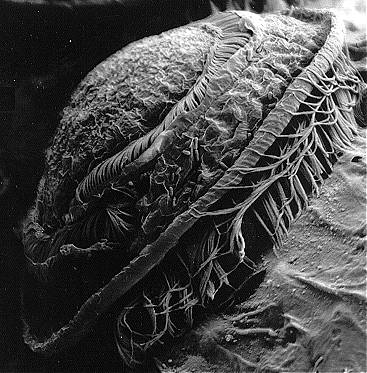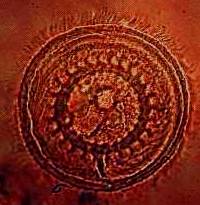All
things koi and H2O
Trichodina
Duncan Griffiths
One fine day you go pond side, to admire your collection of living jewels only to find them flashing and crashing off the pond bottom and sides.
One things is for sure you can bet your best showa that Trichodina will be amongst one of the top candidates for this new found behaviour.
Trichodina is one of the most prevalent ciliate parasites found in the koi hobby, but fortunately for us is also one of the easiest to eliminate and should not represent to much of a problem, though it may seem a bit daunting at the time, with the fish doing cart wheels around the pond to be rid of this critter.
Trichodina is one of the most common and persistent parasites
of them all, with probably well over 200 species to its credit.
Trichodina is to be found in all corners of the globe, on most fishes both
fresh water and salt water.
Trichodina is transmitted by contact and contaminated water, it can also be transported form pond to pond, attached to common amphibians, like Frogs and Toads
In the strict sense of the word, Trichodina is not a true
parasite, as it lives on the koi and does not feed on the† life blood of the koiís, moreover it feeds
on bacteria that† flows around the
parasites mouth,
Trichodina can also survive for great lengths of time without a host, living
in any dirt available, usually in the accumulated mulm and fish waste in the
bottom of dirty filter or pond.
It is generally accepted that an outbreak of Trichodina is associated with
poor water quality and in particular dirty filters or pond bottoms heavy with
mulm and poor pond maintenance, a better reason for keeping the pond system
clean and hygienic, never existed
Trichodina is a disc shaped parasite about 50 microns in size. It is convex on the topside called the anterior side, and convex on the under side called the posterior side.
Hanging down from the underside are around 25 calcified interlocking teeth like projections, called Denticles, these are arranged in a ring or corona around the underside of the parasite pointing towards the fishes epidermis, the parasite uses these to hold on to its host.
Picture taken by an electron microscope

Radiating out from the circumference is an array of fine cilia, which the parasite uses for propelling itself, these cilia can make Trichodina very motile indeed, you will notice Trichodina under the microscope spinning like a top, Trichodina is really quite a mover when it wants or needs to be.
Typical view under a microscope

This is a view looking down on top and through the parasite, the inner circle clearly shows the interlocking Denticles
Itís the joint action of the Denticles and the cilia that irritate as they rasp on the skin surface of the koi, causing the koi to flash off the pond bottom in an attempt to shake this parasite off. This is usually accompanied by an increase in mucus production.
Although Trichodina are not readily associated with mortalities
of koi on there own, except when in great numbers on the gill lamellae, the
blade like Denticles are the prime way the koi gets infections as the epidermis
is breached by the rasping action of the Denticles, secondary bacterial infections
often occur at the site of such a breach in the epidermis
Another way Trichodina damages koi indirectly, is by irritating the koi to
such a point, that in an attempt to shed the parasite it can and does damage
itself on objects in the pond yet again secondary infection can occur.
As stated the underside is concave with the Denticles hanging down and this is the side presented to the koiís skin, the other side is convex and is the side looking away from the koiís skin, this is the side where the mouth and the gullet is located, so the feeding side of this parasite is away from the koiís body.
Trichodina reproduce by binary fission or division and for this reason treatment becomes that much easier, as a typical successful treatment gets all generations of this parasite usually in one treatment.
Trichodina responds well to many treatments:
Chloramines T
Malachite green
Formalin / formaldehyde
Potassium Permanganate††
Salt
By far the best way is without doubt, Potassium Permanganate
Dosed at 1.5 gm per ton 220 gallons or 1.5 ppm
Anything over two hours activity or pink colour of PP
before PP turns brown and is spent, appears to do the trick with usually no
re-treatment needed.
Remembering to use extra O2 in the pond and to take the fish off
the feed 24 hours prior to treatment, as PP does use O2 in its
oxidising process, as digestion puts up the koiís oxygen demand up, its as
well to not place further O2 demand on the pond system whilst treatment
is underway.
Also be aware that a good cleaning of the system is also recommended to help prevent a future reoccurrence of Trichodina,
Secondary bacterial infections to the koi may occur for some time after Trichodina has been banished to the phantom zone as a result of damage inflicted whilst it was active.